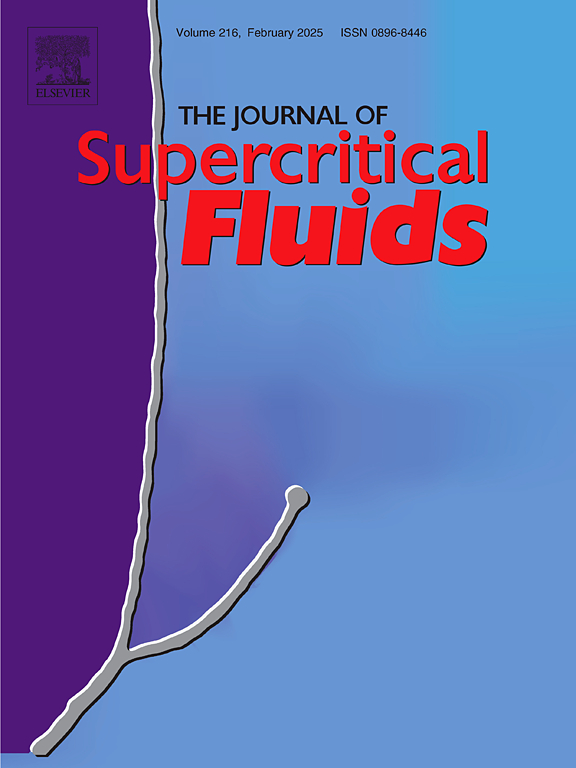Predicting self-diffusion coefficients of light gases in supercritical carbon dioxide: A molecular dynamics method
IF 4.4
3区 工程技术
Q2 CHEMISTRY, PHYSICAL
引用次数: 0
Abstract
The methanation of CO2 and supercritical CO2 (scCO2) fracturing represent effective approaches for CO2 utilization and greenhouse effect mitigation. In these process, light gases like H2, O2, CO, CH4 are commonly involved. However, limited studies have focused on the diffusion behavior of these gases in scCO2 under high-pressure conditions, as well as a shortage of self-diffusion coefficient data and prediction equations specifically designed for scCO2 solvents. To address this gap, molecular dynamics (MD) simulations were employed to compute the self-diffusion coefficients of several light gases in scCO2 across a wide temperature range (313 K–713 K) and at high pressures (75.994 bar, 101.325 bar and 126.656 bar) under infinitely dilute conditions. The effects of temperature, density, viscosity, molecular mass, and solute–solvent interaction energy on the self-diffusion behavior were systematically analyzed. Two empirical equations (a Speedy–Angell-type power-law equation and a newly developed equation incorporating temperature, density, and viscosity) were refitted based on simulation data. The overall relative errors are 4.52 % and 4.44 %, respectively, indicating an improved accuracy compared to conventional experimental and MD-based empirical equations.
超临界二氧化碳中轻气体自扩散系数的分子动力学预测
CO2甲烷化和超临界CO2 (scCO2)压裂是利用CO2和减缓温室效应的有效途径。在这些过程中,通常会涉及H2、O2、CO、CH4等轻气体。然而,这些气体在高压条件下在scCO2中的扩散行为的研究有限,而且缺乏专门为scCO2溶剂设计的自扩散系数数据和预测方程。为了解决这一差距,采用分子动力学(MD)模拟计算了几种轻气体在scCO2中的自扩散系数,在宽温度范围(313 K - 713 K)和高压(75.994 bar, 101.325 bar和126.656 bar)下,在无限稀释条件下。系统地分析了温度、密度、粘度、分子质量和溶媒相互作用能对自扩散行为的影响。根据模拟数据对两个经验方程(speedy - angel型幂律方程和一个新建立的包含温度、密度和粘度的方程)进行了修正。总体相对误差分别为4.52 %和4.44 %,表明与传统实验和基于md的经验方程相比,精度有所提高。
本文章由计算机程序翻译,如有差异,请以英文原文为准。
求助全文
约1分钟内获得全文
求助全文
来源期刊

Journal of Supercritical Fluids
工程技术-工程:化工
CiteScore
7.60
自引率
10.30%
发文量
236
审稿时长
56 days
期刊介绍:
The Journal of Supercritical Fluids is an international journal devoted to the fundamental and applied aspects of supercritical fluids and processes. Its aim is to provide a focused platform for academic and industrial researchers to report their findings and to have ready access to the advances in this rapidly growing field. Its coverage is multidisciplinary and includes both basic and applied topics.
Thermodynamics and phase equilibria, reaction kinetics and rate processes, thermal and transport properties, and all topics related to processing such as separations (extraction, fractionation, purification, chromatography) nucleation and impregnation are within the scope. Accounts of specific engineering applications such as those encountered in food, fuel, natural products, minerals, pharmaceuticals and polymer industries are included. Topics related to high pressure equipment design, analytical techniques, sensors, and process control methodologies are also within the scope of the journal.
 求助内容:
求助内容: 应助结果提醒方式:
应助结果提醒方式:


